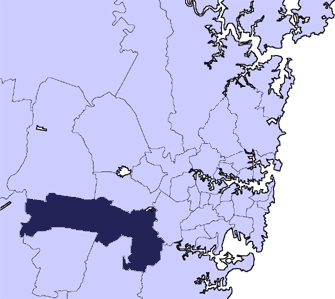City of Liverpool (New South Wales) facts for kids
Quick facts for kids City of LiverpoolNew South Wales |
|
|---|---|

Location in Metropolitan Sydney
|
|
| Population |
|
| • Density | 668.82/km2 (1,732.2/sq mi) |
| Established | 27 June 1872 (as a municipal district) |
| Area | 305.5 km2 (118.0 sq mi) |
| Time zone | AEST (UTC+10) |
| • Summer (DST) | AEDT (UTC+11) |
| Mayor | Ned Mannoun |
| Council seat | Liverpool |
| Region | Greater Western Sydney |
| State electorate(s) |
|
| Federal Division(s) | |
 |
|
| Website | City of Liverpool |
The City of Liverpool is a special area in Sydney, New South Wales, Australia. It's managed by the Liverpool City Council, which is a type of local government. This area covers about 305.5 square kilometers, and its main office is in the suburb of Liverpool.
The leader of the City of Liverpool is the mayor, Cr. Ned Mannoun. He is part of the Liberal Party.
Contents
Who Lives in Liverpool?
In 2016, there were about 204,326 people living in the Liverpool area. Slightly more than half of them were female (50.4%), and 49.6% were male.
The average age of people in Liverpool was 33 years old. This is younger than the average age for all of Australia, which was 38 years. About 22.7% of the population were children aged 0 to 14 years. People aged 65 and over made up 10.4% of the population.
The number of people living in Liverpool has been growing steadily. Between 2001 and 2016, the population increased by a lot, much faster than the average for Australia.
Liverpool is a very diverse place! In 2016, more than half of the homes (57.2%) spoke two or more languages. This is much higher than the Australian average of 22.2%. Only 41.4% of people spoke only English at home, which is lower than the national average of 72.7%.
Many different religions are followed in Liverpool. A large number of residents are Muslim, which is more than four times the national average. Many people are also Catholic or Orthodox.
How Liverpool is Governed
The Liverpool City Council is made up of eleven people called councillors. One of these councillors is the mayor. These councillors serve for a fixed term of four years.
The mayor is chosen directly by the people through a vote. The other ten councillors are elected in two different areas called "wards," with five councillors chosen from each ward. The last election was held on 4 December 2021.
Who is on the Council?
Here's how the council is made up:
| Party | Councillors | |
|---|---|---|
| Liberal Party | 5 | |
| Australian Labor Party | 4 | |
| Liverpool Community Independents Team | 2 | |
| Total | 11 | |
The councillors elected in 2021 are:
| Ward | Councillor | Party | Notes | |
|---|---|---|---|---|
| Mayor | Ned Mannoun | Liberal | Elected 2021–present, also served 2012–2016. | |
| North Ward | Mazhar Hadid | Liberal | Elected 2008. Was Deputy Mayor twice. | |
| Nathan Hagarty | Labor | Elected 2016. | ||
| Ali Karnib | Labor | Elected 2008, and earlier from 1999–2004. Was Deputy Mayor twice. | ||
| Mel Goodman | Liberal | Elected 2021. | ||
| Peter Harle | Community Independents | Elected 2008. | ||
| South Ward | Charishma Kaliyanda | Labor | Elected 2016. | |
| Fiona Macnaught | Liberal | Elected 2021. | ||
| Richard Ammoun | Liberal | Elected 2021. | ||
| Betty Green | Labor | Elected 2021. | ||
| Karress Rhodes | Community Independents | Elected 2016. She is the current Deputy Mayor since 2021. | ||
History of Liverpool
Liverpool is one of the oldest towns in Australia. It was started in 1810 by Governor Lachlan Macquarie. He wanted it to be a place for farming. He named it after Robert Banks Jenkinson, who was an important British official at the time. The city also got its name from the British city of Liverpool.
How the Local Government Started
The first local government in Liverpool was called the Liverpool District Council. It was set up on 19 September 1843. However, this type of government wasn't very popular and stopped working by 1850.
Later, in 1871, many local people asked for a new local government. So, on 27 June 1872, the Municipality of Liverpool was officially created. Richard Sadleir was elected as its first Mayor on 27 August 1872.
Over time, the Municipality of Liverpool grew. On 1 January 1949, it took in part of another area called Nepean Shire. Then, on 9 December 1960, the Municipality was officially named the City of Liverpool.
Growth of the Region
Liverpool is located at the top of the Georges River where boats can travel. Also, the Great Southern Railway, which goes from Sydney to Melbourne, reached Liverpool in the late 1850s. Because of these things, Liverpool became a very important place for farming and transportation. The land around it was very good for growing crops.
During World War I, a large army base was built in Liverpool. This base, called Holsworthy Barracks, is still there today. There are also other military places nearby in Moorebank.
Until the 1950s, Liverpool was mostly a small town focused on farming, especially poultry (chickens) and growing vegetables. But then, Sydney started to grow very quickly. Liverpool became an outer suburb of Sydney, with many working-class families and factories. It also became known for its large public housing areas, built for thousands of families after old parts of inner-city Sydney were redeveloped in the 1960s.
The City of Liverpool is also home to one of the biggest public libraries in Sydney.


